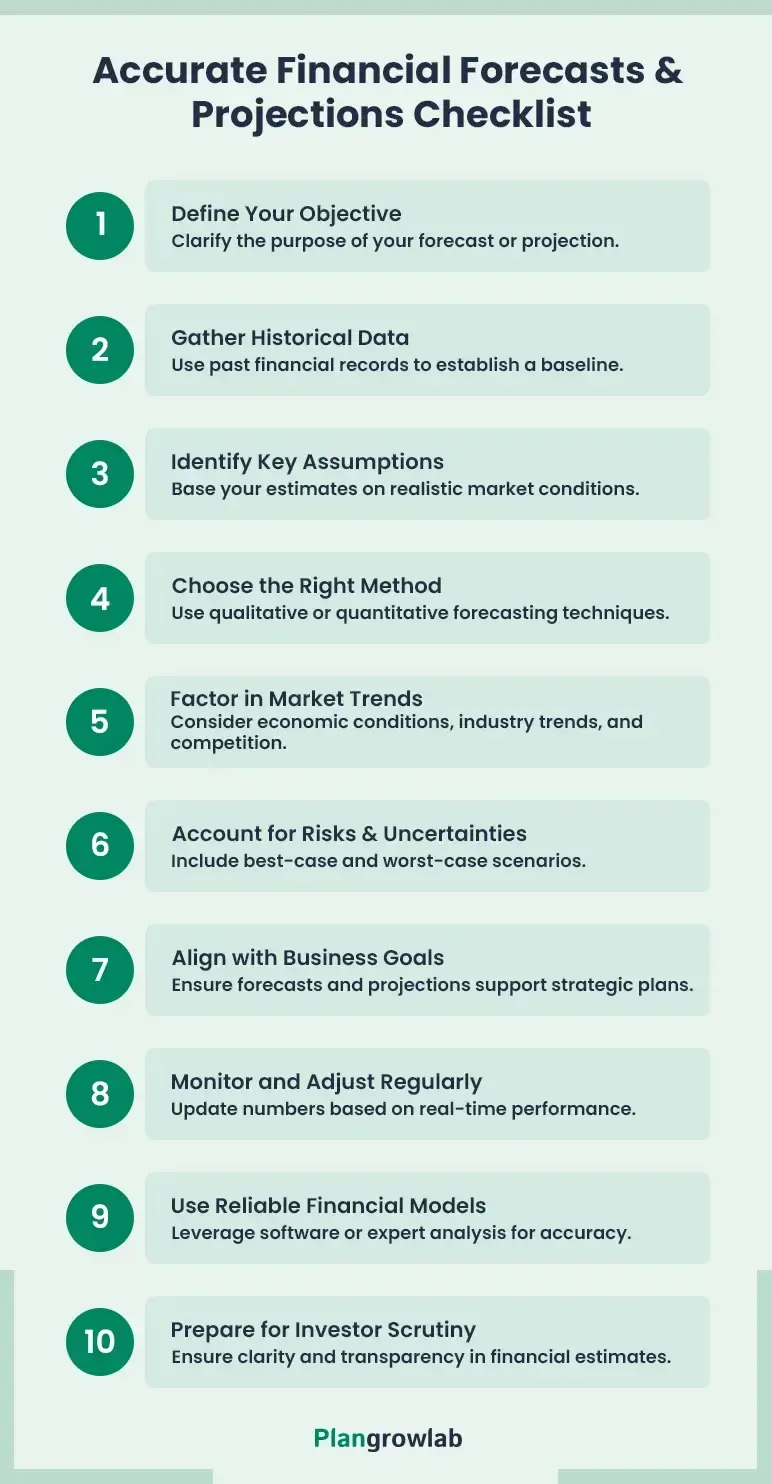Does a financial forecast make realistic predictions, or does a projection? And if a projection predicts realistic finances, then who predicts hypothetical scenarios?
Confusing 😵💫, isn't it? And it's understandable because this subject and its terms can even leave many people scratching their heads.
But not anymore...
In this blog, we'll break down financial forecast vs projection to clear up confusion and help you understand when and how to use each for your business.
Additionally, we will provide steps to create financial projections and forecasts that help you make an informed decision.
Let's get started.
What is a financial forecast?
A financial forecast, aka prospective financial statements or an entity's expected financial position, is a realistic prediction of your business's future financial performance based on current numbers, historical data, trends, and assumptions about the market.
For example, you own a bakery, and over the past year, your sales have steadily grown by 10% each quarter. Based on this trend and current market conditions, you forecast that your sales will increase by another 10% in the next quarter. This is called financial forecasting.
It includes:
- Revenue projections
- Cost of goods sold
- Operating expenses
- Profit margins
- Cash flow statement
- Market and industry trends
- Assumptions and justifications
What is a financial projection?
A projection is more like a what-if scenario. It estimates your business's future performance based on specific assumptions that may or may not happen. It's less about predictions and more about exploring possibilities.
For example, imagine your bakery is considering launching a new line of gourmet cupcakes. You create a financial projection to see your profits if this product sells 500 units per month at $5 each.
This projection assumes that your new product performs well, but it's not based on past data—just a hypothetical scenario to guide your decisions.
The financial projection includes:
- Revenue projections
- Operating expenses
- Profit margins
- Cash flow forecast
- Market and industry trends
- Assumptions and justifications
Financial projection vs. forecast: key differences
Let's explore the key differences between projection vs. forecast, we’ll start with financial projection:
Situations that require financial projection
Financial projection is a core part of every business's financial planning, especially if your business is considering expanding or launching new products. Businesses use projections for multiple purposes, and they are as follows:
- Seeking investment or funding
- Planning for business growth and development
- Evaluating mergers and acquisitions
- Applying for business loans or credits
- Strategizing large marketing campaigns
- Exploring alternative revenue streams
- Budgeting for equipment purchases
Importance of financial projection
There's a common belief that financial projections are just for existing businesses. Not true. The table below highlights how projections are essential for both types of businesses:
| Aspect | Enterprises | Startups |
|---|---|---|
| Long-Term Planning | Helps forecast future financial outcomes and plan for market changes. | Provides a roadmap for scaling and identifying milestones. |
| Growth | Assesses expansion opportunities and the impact on financials. | Evaluates the viability of new products or markets. |
| Resource Allocation | Guides efficient allocation of resources across departments. | Determines how much funding is needed to launch and sustain the business. |
| Risk Management | Identifies financial risks and helps develop mitigation strategies. | Helps in managing uncertainty by predicting potential cash flow challenges. |
| Investor Confidence | Strengthens the case for investment by showcasing financial health and projections. | Attracts investors by illustrating the potential for returns and business growth. |
| Financial Health | Monitors and adjusts financial strategies to maintain stability. | Keeps track of early-stage financial needs and forecasts. |
Key Limitations of Financial Projection:
- Based on assumptions, it is less reliable for short-term decision-making.
- Sudden changes in the market can make projections inaccurate.
- Requires extensive research and industry knowledge to create realistic estimates.
Financial forecast
Now, let’s discover the key…
Situations that require a financial forecast
A financial forecast is based on the responsible party's assumption reflecting the circumstances it's expected to exist. Many companies rely heavily on financial forecasts for decision-making, resource allocation, and business expansion. Here are a few more situations where financial forecasts come into play:
- Estimating cash flow to ensure liquidity.
- Planning for business growth or contraction.
- Setting financial goals and performance targets.
- Optimizing marketing efforts for peak sales seasons.
- Planning equipment upgrades and facility expansion.
- Identifying potential financial risks and opportunities.
- Supporting strategic decision-making and business planning.
Importance of financial forecast
A financial forecast is critical for every business, from startups to established companies, as it helps guide decision-making, manage cash flow, and plan for growth. Here's why it's essential for all businesses:
| Aspect | Established Businesses | Startup Businesses |
|---|---|---|
| Guiding Decision-Making | Helps finance team to make informed decisions on expansion, investments, etc. | Assists in determining viability and identifying key risks. |
| Cash Flow Management | Ensures liquidity and smooth operations by predicting cash needs. | Forecasts tend to help avoid cash shortfalls in the early stages. |
| Planning for Growth | Aids in scaling operations and planning for new opportunities. | Helps establish a roadmap for growth and resource allocation. |
| Securing Investment | Strengthens investor confidence by showcasing financial health. | Attracts investors by presenting a clear financial outlook. |
| Setting Financial Goals | Sets the benchmark for tracking performance and success. | Helps set achievable targets and track progress. |
| Resource Allocation | Assists in optimizing resource use for current and future needs. | Ensures efficient use of limited resources in the startup phase. |
| Risk Management | Identifies potential financial risks and suggests mitigations. | Highlights risks to prepare for uncertainty and market challenges. |
| Strategic Planning | Helps align business strategy with financial goals. | Provides a clear vision of the business's financial trajectory. |
Key Limitations of Financial Forecast:
- Focuses on short-term trends and may not account for long-term growth.
- Relies heavily on historical data, making it ineffective for new businesses.
- Cannot predict the impact of sudden market disruptions or economic downturns.
How to create a financial projection vs. forecast
Preparing a financial projection and forecast is like preparing two strategies for your business's future. Both financial forecasting and projection are different from each other. Let's explore both approaches in this section:
Creating financial projection
The financial projection is all about predicting the future of your business performance based on current trends, assumptions, and goals. Let's find out how we can do that:
1) Identify the purpose and timeframe of your projection
Financial projections primarily focus on future financial results, often spanning multiple years. However, the timeframe can vary depending on the purpose—whether it's for securing funding, internal strategy, or tracking performance over time. Decide if you need quarterly, annual, or multi-year projections to align with your goals.
2) Collect historical data and market analysis
If available, gather the historic financial statements, income statements, cash flow statements, balance sheet, and annual income. New companies without historical data have to rely on analyst reports, industry benchmarks, market research, and other relevant studies or analyses to support their assumptions.
3) Plan for different business circumstances
This step requires you to explore hypothetical assumptions to plan for both success, unexpected events, and potential challenges that may impact financial performance. Consider assumptions from both perspectives: What if you achieve success, and what if you face setbacks? Prepare your business and make projections based on hypothetical courses and “what if” questions.
- What if trends change?
- What if a new competitor enters the market?
- What if the business provides unexpected returns?
- What if a new product launch gets double the sales than expected?
- What does the government imply about new taxation or economic change?
The hypothetical situations you consider for your projections depend on how your business operates, the revenue you want to achieve, and your overall growth and development plans.
4) Forecast expenses
The situations you predicted in the previous step will help you identify your future expenses. For example, if you predict that by launching a new product, the sales have doubled than expected, think about the costs involved. These include direct costs, like producing your product (COGS), and other regular and one-time expenses. Also, consider how expenses may change as your business grows, and spends more time in the market.
5) Create a simple income statement
An income statement summarizes your projected revenue and expenses. It’s a simple annual budgeting process example for quick budgeting:
| Item | Amount |
|---|---|
| Projected Revenue | $1,320,000 |
| Total Expenses | $828,000 |
| Net Income | $492,000 |
Creating financial forecast
Unlike projections, a financial forecast isn't created based on certain assumptions. Instead, it relies on real-time data, historical performance, past trends, and market conditions to predict how your business will perform in the future. Let's dive in to learn how to create one:
1) Analyze real data and trends
Unlike projections, financial forecasts use actual sales figures, expense patterns, and market research to make informed predictions. The aim is to reflect the most likely business performance shortly.
2) Focus on likely outcomes
Forecasts focus on the most probable outcomes by analyzing historical data, seasonal patterns, and economic conditions. Unlike projections, they do not explore hypothetical situations but provide a data-driven outlook to support budgeting, staffing, and operational decisions.
3) Do market analysis
Staying connected with the market is essential. It helps identify the market trends and external as well as internal factors impacting your business. And keeps you updated with competitive dynamics. This knowledge is key for understanding upcoming market changes and how they might affect your revenue, growth, and overall development.
Evaluate external factors
These are circumstances outside your control that can significantly impact your business. Ignoring them can lead to inaccurate forecasts and poor decision-making. By evaluating these factors, you can anticipate risks, identify opportunities, and adjust your strategy accordingly.
You can evaluate external factors by:
- Identifying key external factors like regulatory changes, technological advancements, and even geopolitical events.
- Assess their potential impact that might affect your revenue, costs, or operations.
- Incorporate them into your forecast based on the detailed insights you gather.
For example, if inflation rises, consumers may cut back on discretionary spending. This could lead to lower sales for your business. You might reduce your revenue growth assumption in your forecast from 8% to 5%.

Hire experts to build accurate forecasts & projections
In this blog, we dived into the details of financial forecasts vs. projections, and it's clear both are vital yet tricky and time-consuming.
Gathering historical data, evaluating the numbers, making assumptions, and whatnot—feels like an endless task!
That's where our financial forecasting service comes in. From gathering and analyzing historical data to building accurate forecasts and projections, our experts can guide you through every step with precision.
Our forecasting and projection services have helped hundreds of businesses organize their finances, impress their audience, and raise millions.
Connect to our experts today!
Frequently Asked Questions
Do you need both forecasts and projections?
Yes, forecasts guide annual budgeting using historical data, while projections explore “what-if” scenarios based on assumptions. Using both offers a complete financial outlook.
What is the difference between forecast and projection?
Forecasts predict future performance based on trends, while projections estimate hypothetical outcomes using assumptions and strategic insights.
Should you hire experts for financial projections?
Yes, experts ensure accuracy, align projections with business goals, and enhance decision-making, especially for funding or expansion plans.

